Dec-25-21
 | | KEG: The Ponziani was von Popiel's pet opening at this point in his career. Napier initially handled the opening nicely, but then--facing the sort of position in which von Popiel was especially comfortable, made a doubtful choice on move 9 and erred badly on moves 13 and 16 and was lost after that. von Popiel missed chances to pull the trigger on moves 22, 23, 24, and 26 and almost let Napier back in the game, but he finally found 27. d5 and then completely blew Napier away. All in all, a good performance by von Popiel despite a few hiccups. 1. e4 e5
2. Nf3 Nc6
3. c3
After he defeated Janowski in a Ponziani opening at Munch 1900, it became von Popiel's opening of choice after 1. e4 e5. This opening did not always go well for von Popiel (e.g., he got thrashed by Pillsbury at Hanovr 1902), but his greater familiarity with the tricks and traps of this opening paid dividends for him here. 3... d5
4. Qa4
The possibility of inflicting pressure on Black with this moves is one of the themes of the Ponziani. I am not a fan of this opening, but it can be troublesome to meet over the board against an opponent who is schooled in its intricacies. 4... f6
5. Bb5
A customary set-up for White in the Ponziani:
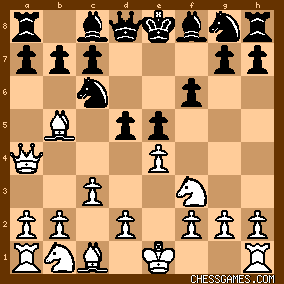
click for larger viewIf anything, Black is for choice here, and thus few strong players have followed von Popiel's lead in his opening selection. 5... Nge7
6. exd5 Qxd5
7. d4
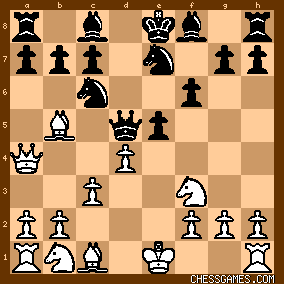
click for larger viewNapier reached this same position as Black in the game he won from Reggio at Monte Carlo. This position was also reach in the afore-mentioned win by Pillsbury against von Popiel at Hanover 1902. 7... Bd7
"The text is a generally useful move." (Tournament Book) I don't know what that means, but the text--also played by Napier against Reggio and by Pillsbury against von Popiel--is reasonable, but 7...e4 or 7...Bg4 look more enterprising. Black can also play 7...a6 and achieve some advantage. 8. Be3
Somewhat tentative. White is about even with 8. 0-0 and can also play 8. dxe5, both of which seem marginally stronger than the text. 8... exd4
8...Nf5 looks better, but the text was played by Pillsbury in his game at Hanover against von Popiel, so who am I to argue. 9. cxd4

click for larger viewThus far, Napier had played the opening competently and almost certainly had the (slightly) better (theoretical) chances. But here he missed a clever nuance that Pillsbury sprung on von Popiel in their game at Hanover. 9... Nc8?
Much better was Pillsbury's 9...Ne5! Also better than the wimpy text were 9...Qh5 and 9...0-0-0.. After the text, Napier's position--though not terrible, was not a thing of beauty: 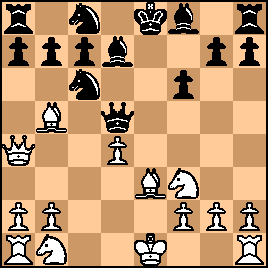
click for larger view10. Nc3 Bb4
11. 0-0
Reggio here played the inferior 11. BxN in the game he lost later in the tournament to Napier. As is obvious, Napier fancied his chances as Black here (though why I cannot fathom). This was all, of course, before Pillsbury's improvement for Black on move 9. 11... BxN
12. bxB Nb6
"This game demonstrates that the position of this Knight on b6 is not good." Nonsense. Napier lost because of his upcoming blunders, not because of positioning of his Knight. 13. Qb3

click for larger view |
|
Dec-25-21
 | | KEG: Post II
13... Be6?
"?"--(Tournament Book)
"This enables White to play an elegant and decisive attack. Better was 13...QxQ." (Tournament Book) The Tournament Book was correct to the extent it called the text an error, and was correct that 13...QxQ was superior. But it got everything else wrong. First, even though 13...QxQ was better than the very weak text, best play for Black here was 13...Na5 which would lead to equality for Black after 14. QxQ (forced) NxQ 15. Bd3 and then 15...0-0-0 or 15...0-0. Furthermore, though the text was bad, as will be seen Black was not yet quite lost. The position was now:
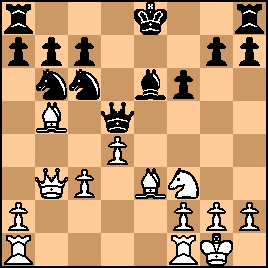
click for larger view14. c4
"!"--Tournament Book.
14. c4 was definitely strong, but so also were 14. Rfc1; 14. Rfb1; or 14. Nd2. A series of pretty much forced exchanges left Black in trouble but probably not yet lost: 14... Nxc4
15. BxN QxB
16. Qxb7
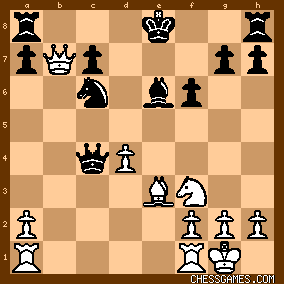
click for larger viewBlack will lose material, but he could get decent counterplay with 16...Rb8 17. Qxc7 0-0. White would end up a pawn to the good in this line, but Black would be well-developed and would have pressure on White's isolated d-pawn. Hardly a hopeless scenario for Black. But instead, Napier, trying to maintain material equality, put his King in jeopardy from which he never escaped: 16... Kd7?
Now, Black was truly lost, and from here on it should have been target practice for von Popiel, the ugly (for Black) position now being: 
click for larger view17. Bf4 Na5
18. Qe4.
18. Qb1 was also very strong.
This left:

click for larger view18... Qd5?
18...Rac8 was the best chance (forlorn as it may be) to offer resistance to White's powerful attack. 19. Qf3 Nc4
20. Rfc1
It is hard to understand why von Popiel didn't play the other Rook to c1 and leave the Rook on f1 free to create mischief for Black on the d or e files. 20... Rac8
21. Rc3
21. Nd2 was much stronger, though the text(planning to double Rooks on the c-file) almost certainly is also sufficient to win. The position was now:
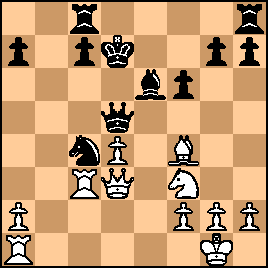
click for larger view |
|
Dec-25-21
 | | KEG: Post III
21... g6?
Napier had to try an immediate 21...Nd6. This would prepare for an eventual attempt by White to put his Knight on e4 and would also prepare for a possible assault on the d-file by White. The text, which prepares for a later Bf5, was comparatively unhelpful. 22. Rac1
Much better was 22. Nd2!, allowing the White Queen to penetrate on the Queen-side and eyes Ne4 and Rc5. All-in-all, a killing move. 22... Nd6
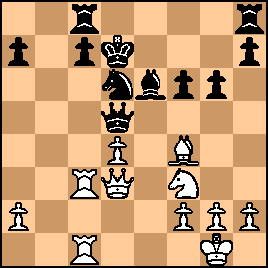
click for larger view23. a3?
Instead of worrying about his a-pawn, White should have played to grind Black down (with the Black king exposed, losing or winning a pawn was hardly the key) with 23. Rc5 or maybe 23. Qa6. Now suddenly, Black had a glimmer of hope:

click for larger view23... Qf5?
Anxious to trade Queens to relieve the pressure. But White can foil/sidestep this easily. Best for Black and offering the stiffest resistance were 23...c6 or 23...Rhd8 or maybe 23...Rhe8. Now, White had a clear winning concept:

click for larger view24. Qd2
Not blowing the win, but entirely too tentative. The fastest route to winning lay in 24. d5!, e.g., 24...Bxd5 25. Qd2 g5 26. Bg3, leaving White--though temporarily a pawn down--with an unstoppable attack. 24... g5!
The best chance.
25. Bg3

click for larger view25... Rhd8?
With 26. d5 threatened, Napier had to play 25...Bd5. He would still be in trouble, but would avoid immediate catastrophe. Now, however, White had a clear winning combination. But... 26. Rc5?
Suddenly the win for White became problematic. He should simply have played 26. d5 (e.g., 26...Bg8 (not 26...Qxd5 27. Rd3 and wins) 27. Ne4. A perch for the White Knight that Black should have strained to prevent. After 26. Rc5?, the position was:

click for larger viewBlack now was in the best shape he had enjoyed since 16...Kd7? But here, as I will discuss in my next post on this game, Napier erred once again, and this time he was summarily crushed. |
|
Dec-25-21
 | | KEG: Post IV
26... Qe4?
Just when Napier had half a chance, bobbled for the last time, and this time von Popiel took full advantage. It should have been obvious from von Popiel's 26. Rc5 that he was preparing (or--more accurately--over-preparing) for d5. 26...Ne4 would cost a pawn or two, but Napier would have have more than a bit of counterplay, e.g., 26...Ne4 27. RxQ (or perhaps better still 27. Rxc7+ RxR 28. RxR+ Ke8 29. Qb4 Rd7 30. Rd8+ Rd8 31. RxR+ KxR 32. Qb8+ Ke7
33. Qxa7+ Kf8 34. a4 Bd5 with Black still lost and down two pawns but some practical chances) 27...NxQ 28. Rxf6 NxN+ 29. RxN c6 leaving Black a pawn down but again with some real practical chances. After Napier's actual 26...Qe4?, what followed was a massacre: 27. d5!
Black is busted.
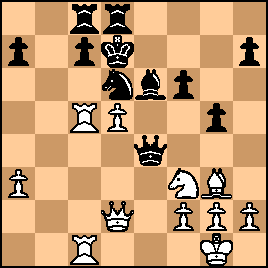
click for larger view27... Bf5
Hopeless, but nothing else is any good either.
28. Qa5
28. Qc3 is also brutal.
28... Ne8?
This was pure surrender. But nothing would have enabled Napier to hold on very long. The position was now:

click for larger view29. Qb5+
This wins the White Queen, but--believe it or not--29. Re1 or 29. R5c4 were even stronger (if that makes sense in this context). 29... Ke7
30. Re1
As was said to the young Beth Harmon in "The Queen's Gambit," this is where you resign. 30... Rb8
31. RxQ+ BxR
32. Qe2

click for larger viewIf Napier was dreaming of some sort of back-rank miracle mate, he was not surely disillusioned. Therefore:
1-0 |
|
|
|
|





































